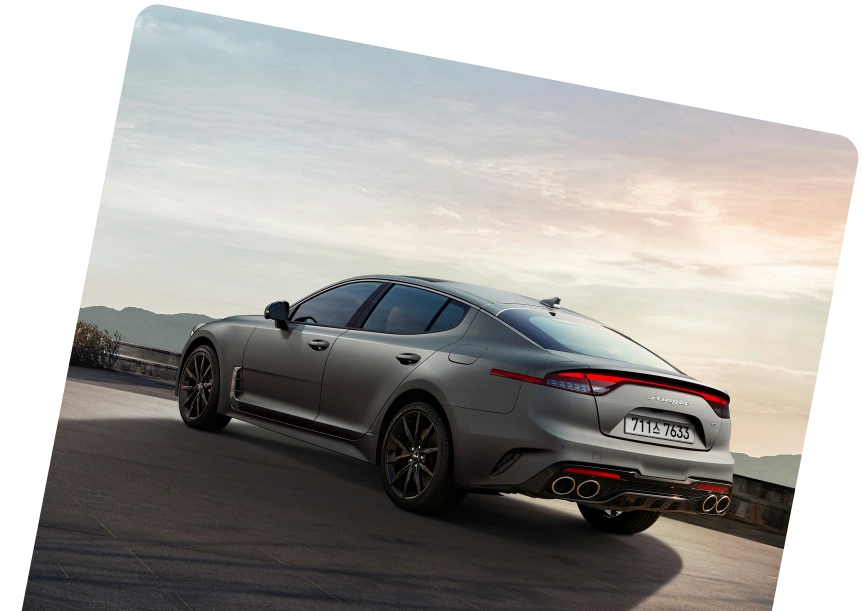
SUVs like the Ford Kuga and Hyundai Tucson have quickly become go-to choices for families. They’re roomy enough for pushchairs and child seats, and offer that high-up, confident view of the road. But which one is better for you?
We’ve put together a comparison to show how they stack up in practicality, performance, comfort, and overall value.
Quick Overview
If you’re trying to decide between the Kuga and Tucson, here’s a side-by-side snapshot:
| Ford Kuga | Hyundai Tucson |
Dimensions | 4,645 × 1,882 × 1,742 mm | 4,520 × 1,865 × 1,635 mm |
Horsepower | 150-243hp | 150-265hp |
0-60 mph | 9.7 sec (1.5L petrol) | 10.3 sec (1.6L petrol); hybrids slightly quicker |
Seats | 5 | 5 |
Fuel options | Petrol, diesel, full hybrid, plug-in hybrid | Petrol, mild hybrid, full hybrid, plug-in hybrid |
Gearbox options | Manual, automatic | Manual, Automatic |
Boot space | 412-645L (non-hybrid), 616-628L (hybrid) | 620-1,799L (non-hybrid); 546L (mild hybrid) |
Price Comparison
A new Kuga costs roughly £33,000 to £43,000, depending on the trim. The latest Tucson starts at around £33,000 and can reach £46,000 for higher-spec models. A new hybrid will be at the higher end of the price range for both models.
On the used market, a used Ford Kuga from 2018 with about 50,000 miles typically sells for at least £10,000. A Tucson of similar age and mileage also starts at around £10,000, but usually sits a bit higher.
Engine Options
The Ford Kuga starts with a 1.5-litre EcoBoost petrol, paired with a six-speed manual gearbox. There’s also a 2.5-litre full hybrid system that combines electric and petrol power, available with either front- or four-wheel drive and a CVT automatic gearbox. The plug-in hybrid uses the same 2.5-litre petrol engine but adds an electric motor for an electric-only driving range for short trips, and it comes with the same CVT automatic.
The Tucson begins with a 1.6-litre petrol engine with a manual gearbox, and buyers can step up to a mild-hybrid 1.6 T with a seven-speed automatic and front- or four-wheel drive. A full hybrid option is available for more electric-assisted driving. The top plug-in hybrid has a larger battery for shortEV journeys and an automatic gearbox..
Performance
The Kuga offers a drive that feels confident. Even with a heavier Kuga hybrid or PHEV powertrain, body control remains steady and steering feels direct, so changes of direction feel precise. Suspension absorbs bumps well without making the ride harsh, and four-wheel-drive versions keep traction secure on slippery surfaces.
The Tucson takes a more relaxed approach to the driving experience. It is comfortable over long journeys, with suspension that smooths out uneven surfaces. Handling is predictable, though cornering has a gentler feel than the Kuga. The hybrids add extra weight, which softens the ride slightly, and the automatic gearbox can be a bit slow to react when you need extra acceleration.
Interior
The Kuga’s cabin feels practical and straightforward. The driving position is easy to adjust and gives good visibility, while controls sit where you expect, with physical buttons for the essentials and the touchscreen for navigation and entertainment. Most materials feel solid, though some plastics on lower trims come across as a bit plain.ST-Line models add leather and suede details, which lift the cabin’s sporty atmosphere.
Rear passengers have plenty of leg- and headroom, and the sliding rear bench gives flexibility for tall adults.
Tucson’s interior has a more modern and considered feel. The dashboard flows into the iPad-style driver display, giving a unified look, while the dual screens have crisp graphics. Small metal-effect touches addstyle without overdoing it.
Rear seat passengers have generous head- and legroom. The cabin manages to feel polished and well thought-out, without making it complicated or awkward to use.
Boot Space
The Ford Kuga has a practical and adaptable boot. With the rear seats in their normal position, it offers 475 litres of space, enough for shopping, sports gear, or school bags. Sliding the rear bench forwards increases flexibility, and folding the seats down opens up to 1,534litres in the Kuga for larger items.
The Hyundai Tucson offers a roomier boot, with 620 litres of space in non-hybrid models. Folding the rear seats creates 1,799 litres. In Tucson hybrid versions, the battery sits under the boot floor, but the main area stays mostly clear, with 616 litres with the seats up and 1,799 litres when they’re folded. The flat floor and well-placed tie-down points make it easy to organise and secure what you need to carry.
Technology
The Kuga comes with an 8-inch touchscreen infotainment system, while higher trims have a 13-inch display and a 12.3-inch digital instrument cluster. Ford’s SYNC 3 system puts navigation, media, and smartphone features within easy reach. Optional extras include a powered tailgate, wireless charging, and upgraded sound systems.
The Tucson feels more modern with its standard equipment levels: a 10.25-inch touchscreen and a separate digital driver display. Navigation, media, and vehicle settings are easy to use, and the system responds quickly. Standard features include smartphone integration and connected services. Higher trims bring premium audio, wireless charging, and extra USB ports.
Reliability
The Kuga generally holds up well over time. Owners report few major issues if regular servicing is kept up to date. Ford’s standard three-year or 60,000-mile warranty is an asset, and parts and servicing are widely available.
The current Tucson has a strong reputation for reliability, too. Long-term reviews and owner feedback suggest it performs consistently with minimal faults. Even better news, Hyundai’sfive-year warranty with unlimited mileage covers more than the Kuga’s standard package. Maintenance is simple, and parts are easy to source.
Safety and Driver Assistance
The Ford Kuga has a full five-star Euro NCAP safety rating and offers a strong range of safety features. Lane-keep assist and lane-departure warnings help you stay on course, and post-collision braking reduces the risk of follow-up accidents. Airbags sit throughout the cabin, and higher trims addblind-spot monitoring and rear cross-traffic alert.
The Hyundai Tucson also carries a five-star Euro NCAP rating and packs in a comprehensive set of safety features. Standard items include forward-collision warning, automatic emergency braking, and blind-spot collision warning. Higher trims bring lane-follow assist and rear cross-traffic collision-avoidance systems.
Running Costs and Ownership
Here’s a look at what it takes to run and look after each SUV over time:
Fuel and Energy Efficiency
The Kuga is very economical, especially with diesel engines that return over 50mpg. Its petrol plug-in hybrid can achieve over 200mpg if used as intended.
The Tucson’s petrol models manage around 40mpg, with mild hybrids slightly higher. The full and plug-in hybrid options offer good fuel savings, with the PHEV able to cover about 40 miles on electric power alone.
Insurance
Insurance costs for both SUVs vary depending on model, engine, and where you live.
The Kuga generally falls into groups of 10 to 27, with an average annual cost of around £817. The Tucson sits in groups of 12 to 27, with comparable costs. In both cases, higher-spec or more powerful engines push the cost up, and entry-level models are easier on the wallet in all aspects.
Servicing
The Kuga typically costs between £65 and £155 per service for basic checks, oil changes, and routine maintenance. Ford’s network of service centres also makes it easy to find support when needed.
The Tucson costs a little more on average, with servicing ranging from £75 to £235, depending on the type of maintenance and whether it’s a hybrid or petrol model.
Tax
Road tax is standard for mid-sized family SUVs, with hybrid and PHEV variants offering some savings. Company car drivers will also benefit from lower BIK rates on electrified models.
Depreciation
Like all cars, the Kuga and Hyundai Tucson lose value over time, but the pace varies by model, age, and specification. Tucson models tend to hold onto their value a little better. The Kuga starts lower, so it can feel more affordable at first, but it also drops in value steadily over the first few years.
Hybrids on either model can keep their value a bit better thanks to interest in fuel-efficient cars.
How Carplus Helps You Finance the Car You Want
Finding the right car is only half the story – actually getting it can be tricky if you’re on a budget. Carplus makes it easier by offering flexible financing options that fit your circumstances. Our process is simple, with clear terms and no hidden surprises, so you can spend your energy on finding the right car instead of filling out forms and studying fine print.
Explore your choices today!
Which SUV Suits You Best?
Choosing an SUV depends on what matters most to you. Space, comfort, fuel efficiency, or features may take priority, and different models offer different strengths:
Urban and Short Trips
The Ford Kuga fits well in urban driving. Its size makes parking and moving through streets easier, and the cabin has enough space for passengers and daily shopping. On a twisty road, the Kuga feels sharper and more composed than you might expect from an SUV.
Motorway Driver
The Hyundai Tucson works well for long-distance journeys. Its stable handling and spacious interior make trips more comfortable, and the hybrid assistance delivers enough power while keeping fuel use reasonable.
Tech-Savvy Family
Families who like modern design and technology features may prefer the Tucson. Its infotainment tech is clear and simple to use, and the cabin and boot handle child seats and luggage without fuss.
Budget-Focused Buyer
The Kuga is sensible for those watching costs. There are plenty of trims and used models at reasonable prices.
Verdict
Which is the better choice for you: the Hyundai Tucson vs the Ford Kuga? These two SUVs are very similar, and you’re likely to be happy with either choice.
The Ford Kuga will appeal to those who enjoy a more engaging drive and a few extra options at a lower price. The Hyundai Tucson, on the other hand, draws attention with its style, practical interior, and more modern tech. If you want a hybrid with a bit more power or a cabin that feels a little more refined, it may tip the balance in its favour.
Both offer strong value as used cars, so think about what matters to you.
Table of Contents








